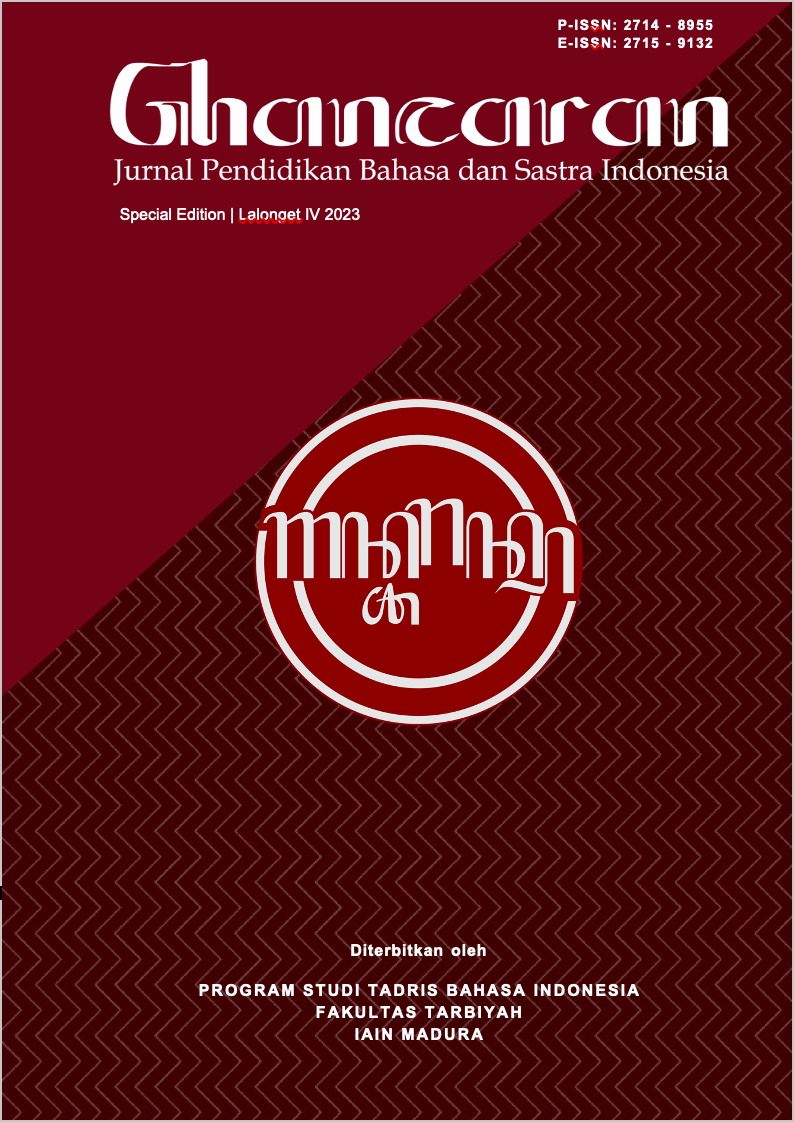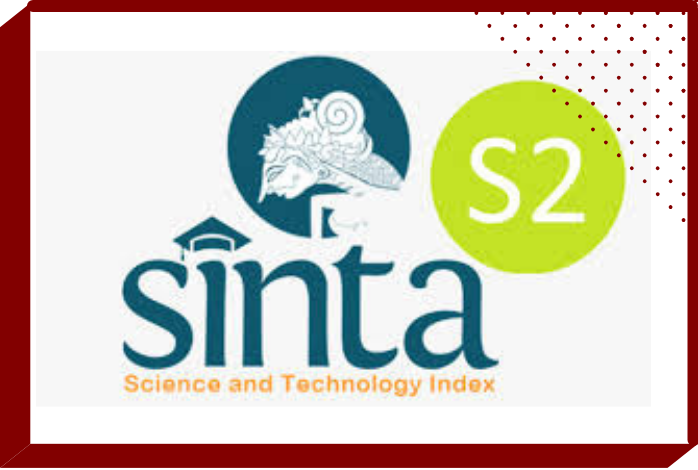Rasionalitas Implementasi Chat GPT dalam Pembelajaran Keterampilan Menulis Karya Ilmiah
 Abstract views: 1132
,
Abstract views: 1132
,
 PDF downloads: 898
PDF downloads: 898
Abstract
Since its release into the public domain, Chat GPT has taken the world by storm with its advanced capabilities. Chat GPT's extraordinary ability to produce scientific writing seems to be starting to revolutionize the existing practice of scientific writing. This research is an exploratory study that synthesizes the latest literature to review the opportunities and potential of Chat GPT in learning to write scientific papers. The research data collection technique uses library research in the form of research results and theories that are relevant and in accordance with the purpose of the writing. A literature search was carried out using the Google Scholar and ERIC Document search engines. At the end, this article recommends how to collaborate artificial intelligence with natural writing to produce quality scientific writing. The use of Chat GPT can play a role in the production process of scientific writing while still displaying the creativity and innovation of the writer himself.
Downloads
References
Afroz, H., Jasmeet, J., Vashist, V., & Kathri, I. (2021). Creativity and Artificial Intelligence. International Journal For Technological Research In Engineering, 9(3), 26–31.
Analytica, O. (2020). Gpt-3 AI language tool calls for cautious optimism. Emerald Expert Briefings, oxan-db.
Brown, H. D. (2000). Principles of language learning and teaching (Vol. 4). longman New York.
Buchkremer, R., Demund, A., Ebener, S., Gampfer, F., Jägering, D., Jürgens, A., Klenke, S., Krimpmann, D., Schmank, J., & Spiekermann, M. (2019). The application of artificial intelligence technologies as a substitute for reading and to support and enhance the authoring of scientific review articles. IEEE Access, 7, 65263–65276.
Chan, A. (2023). GPT-3 and InstructGPT: Technological dystopianism, utopianism, and “Contextual” perspectives in AI ethics and industry. AI and Ethics, 3(1), 53–64.
Chassignol, M., Khoroshavin, A., Klimova, A., & Bilyatdinova, A. (2018). Artificial Intelligence trends in education: a narrative overview. Procedia Computer Science, 136, 16–24.
Dergaa, I., Chamari, K., Zmijewski, P., & Saad, H. Ben. (2023). From human writing to artificial intelligence generated text: examining the prospects and potential threats of ChatGPT in academic writing. Biology of Sport, 40(2), 615–622.
Dhamija, P., & Bag, S. (2020). Role of artificial intelligence in operations environment: a review and bibliometric analysis. The TQM Journal, 32(4), 869–896.
Elbow, P. (1998). Writing with power: Techniques for mastering the writing process. Oxford University Press.
Gao, C. A., Howard, F. M., Markov, N. S., Dyer, E. C., Ramesh, S., Luo, Y., & Pearson, A. T. (2022). Comparing scientific abstracts generated by ChatGPT to original abstracts using an artificial intelligence output detector, plagiarism detector, and blinded human reviewers. BioRxiv, 2012–2022.
Hakim, S. (2023). Kontribusi Pembelajaran Sejarah Kebudayaan Islam di Madrasah Tsanawiyah Terhadap Pembentukan Moral dan Intelektual Siswa. JUPE: Jurnal Pendidikan Mandala, 8(1).
Johinke, R., Cummings, R., & Di Lauro, F. (2023). Reclaiming the technology of higher education for teaching digital writing in a post—pandemic world. Journal of University Teaching & Learning Practice, 20(2), 1.
Kumar, H., Musabirov, I., Shi, J., Lauzon, A., Choy, K. K., Gross, O., Kulzhabayeva, D., & Williams, J. J. (2022). Exploring the design of prompts for applying gpt-3 based chatbots: A mental wellbeing case study on mechanical turk. ArXiv Preprint ArXiv:2209.11344.
Lee, S., & Carpenter, R. (2015). Creative thinking for 21st century composing practices: Creativity pedagogies across disciplines. Across the Disciplines, 12(4), 1–24.
Madjid, S., Emzir, E., & Akhadiah, S. (2017). Improving Academic writing skills through contextual teaching learning for students of Bosowa University Makassar. Journal of Education, Teaching and Learning, 2(2), 268–272.
Mardhiyah, R. H., Aldriani, S. N. F., Chitta, F., & Zulfikar, M. R. (2021). Pentingnya keterampilan belajar di abad 21 sebagai tuntutan dalam pengembangan sumber daya manusia. Lectura: Jurnal Pendidikan, 12(1), 29–40.
Marr, B. (2020). What is GPT-3 and Why is it Revolutionizing Artificial Intelligence? Forbes Enterprise-Tech.
Marrone, R., Taddeo, V., & Hill, G. (2022). Creativity and Artificial Intelligence — A Student Perspective. 1–11.
Marti, G. (2022). From data to trade: A machine learning approach to quantitative trading. Available at SSRN.
Munawar, Z., Soerjono, H., Putri, N. I., & Dwijayanti, A. (2023). Manfaat Kecerdasan Buatan ChatGPT Untuk Membantu Penulisan Ilmiah. TEMATIK, 10(1), 54–60.
Nainggolan, A. M., & Daeli, A. (2021). Analisis Teori Perkembangan Kognitif Jean Piaget dan Implikasinya bagi Pembelajaran. Journal of Psychology Humanlight, 2(1), 31–47.
Nakazawa, E., Udagawa, M., & Akabayashi, A. (2022). Does the Use of AI to Create Academic Research Papers Undermine Researcher Originality? AI, 3(3), 702–706.
Oatley, K., & Djikic, M. (2008). Writing as thinking. Review of General Psychology, 12(1), 9–27.
Obeng-Ofori, D. (2014). Developing the culture and discipline of conducting and publishing scientific research: Guiding principles. Journal of Energy and Natural Resource Management, 1, 1–7. https://doi.org/10.26796/jenrm.v1i0.9
Pontjowulan, P. (2023). Implementasi Penggunaan Media ChatGPT dalam Pembelajaran Era Digital. Educationist: Journal of Educational and Cultural Studies, 2(2), 1–8.
Reiss, M. V. (2023). Testing the reliability of chatgpt for text annotation and classification: A cautionary remark. ArXiv Preprint ArXiv:2304.11085.
Putikadyanto, A. P. A., Efendi, A. N., Romadhon, S., Amin, M. B., & Sefrianah, N. A. (2021). Persepsi Siswa terhadap Pembelajaran Bahasa Indonesia Berbasis Daring di SMAN 1 Pasuruan. GHANCARAN: Jurnal Pendidikan Bahasa dan Sastra Indonesia, 104-116.
Putikadyanto, A. P. A., Zamahsari, G. K., & Thoha, M. (2022, November). A Bibliometric Analysis of Digital Game-Based Language Learning to Support Future Language Learning. In Proceedings of the 7th International Conference on Sustainable Information Engineering and Technology (pp. 207-211).
Rugaiyah, R., & Madhakomala, R. (2023). Kompetensi Pedagogik Guru Dalam Perspektif Neurosains: Tinjauan Sistematis Dan Meta Analisis. Educational Journal of Bhayangkara, 3(1), 39–52.
Sachdev, P. S., Blacker, D., Blazer, D. G., Ganguli, M., Jeste, D. V, Paulsen, J. S., & Petersen, R. C. (2014). Classifying neurocognitive disorders: the DSM-5 approach. Nature Reviews Neurology, 10(11), 634–642.
Sezgin, E., Sirrianni, J., & Linwood, S. L. (2022). Operationalizing and implementing pretrained, large artificial intelligence linguistic models in the US health care system: outlook of generative pretrained transformer 3 (GPT-3) as a service model. JMIR Medical Informatics, 10(2), e32875.
Sharma, R. C., Kawachi, P., & Bozkurt, A. (2019). The landscape of artificial intelligence in open, online and distance education: Promises and concerns. Asian Journal of Distance Education, 14(2), 1–2.
Shen, Y., Heacock, L., Elias, J., Hentel, K. D., Reig, B., Shih, G., & Moy, L. (2023). ChatGPT and other large language models are double-edged swords. In Radiology (Vol. 307, Issue 2, p. e230163). Radiological Society of North America.
Sholihatin, E., Saka, A. D. P., Andhika, D. R., Ardana, A. P. S., Yusaga, C. I., Fajar, R. I., & Virgano, B. A. (2023). Pemanfaatan Teknologi Chat GPT dalam Pembelajaran Bahasa Indonesia di Era Digital pada Mahasiswa Universitas Pembangunan Nasional Veteran Jawa Timur. JURNAL TUAH: Pendidikan Dan Pengajaran Bahasa, 5(1), 1–10.
Subiyantoro, H., Hartono, R., Fitriati, S. W., & Faridi, A. (2023). Dampak Kecerdasan Buatan (AI) terhadap Pengajaran Bahasa Inggris di Perguruan tinggi: Tantangan dan Peluang. Prosiding Seminar Nasional Pascasarjana (PROSNAMPAS), 6(1), 346–349.
Sumakul, D. T. Y. G., Fuad, A. H., & Sukyadi, D. (2022). Artificial Intelligence in EFL Classrooms : Friend or Foe ? LEARN Journal: Language Education and Acquisition Research Network, 15(1), 232–256.
Suyitno, I. (2012). Menulis Makalah dan Artikel. Bandung: PT Refika Aditama.
Syarifah, S. (2019). Konsep kecerdasan majemuk howard gardner. Sustainable Jurnal Kajian Mutu Pendidikan, 2(2), 176–197.
Thorp, H. H. (2023). ChatGPT is fun, but not an author. In Science (Vol. 379, Issue 6630, p. 313). American Association for the Advancement of Science.
van Dis, E. A. M., Bollen, J., Zuidema, W., van Rooij, R., & Bockting, C. L. (2023). ChatGPT: five priorities for research. Nature, 614(7947), 224–226.
Veronica, A. R., Siswono, T. Y. E., & Wiryanto, W. (2022). Hubungan Berpikir Komputasi dan Pemecahan Masalah Polya pada Pembelajaran Matematika di Sekolah Dasar. ANARGYA: Jurnal Ilmiah Pendidikan Matematika, 5(1), 115–126.
Wartman, S. A., & Combs, C. D. (2018). Medical education must move from the information age to the age of artificial intelligence. Academic Medicine, 93(8), 1107–1109.
Zubaidah, S. (2018). Mengenal 4C: Learning and innovation skills untuk menghadapi era revolusi industri 4.0. 2nd Science Education National Conference, 13(2), 1–18.
Copyright (c) 2023 GHANCARAN: Jurnal Pendidikan Bahasa dan Sastra Indonesia

This work is licensed under a Creative Commons Attribution-ShareAlike 4.0 International License.
Ghancaran: Jurnal Pendidikan Bahasa dan Sastra Indonesia uses an Open Access Policy under the Creative Commons Attribution-ShareAlike 4.0 International License. Authors publishing in this journal agree to the following terms:
- Ghancaran Journal holds the copyright and grants the journal rights for first publication with the work simultaneously licensed under a

The work is distributed under Creative Commons Attribution-ShareAlike 4.0 International License which allows others to share, copy, and redistribute the material in any media or format and adapt, remix, change, and develop the material even for commercial purposes, as long as it is stated credit and license derivative works under similar terms. - Authors may make additional contractual arrangements for non-exclusive distribution of the journal's published work version.
- Authors are permitted to post their work online (e.g., in institutional repositories or on their websites) before and during submission, as doing so may lead to productive exchange.



















